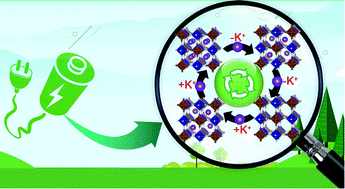Low defects potassium cobalt hexacyanoferrate as a superior cathode for aqueous potassium ion batteries†
Abstract
Aqueous alkali ion batteries attract increasing attention due to their merits of being safety, eco-friendly and low cost. Nevertheless, their development is hindered by the lack of suitable electrode materials with high capacity and cycling stability. As promising candidates, Prussian blue and its analogues (PBAs) are particularly attractive cathode materials in the energy storage field for their excellent electrochemical properties. Co-based PBAs (CoHCF) have relatively high discharge plateau, high theoretical capacity and good cycle performance. The potassium storage mechanism of CoHCF is still unclear and lacks study. Herein, a novel low-defect CoHCF was synthesized by a feasible coprecipitation method. When applied in aqueous potassium ion batteries (AKIBs), the two-electron-transfer process is observed clearly. The CoHCF electrode delivers a high reversible capacity of 83.6 mA h g−1 at a current density of 20 mA g−1 after 200 cycles. In addition, excellent rate performance and long cycling stability at 600 mA g−1 were obtained. The structural evolution and reaction mechanism of CoHCF upon K+ extraction/insertion were visibly characterized by ex situ X-ray diffraction and X-ray photoelectron spectroscopies. The results demonstrate a new strategy for the development of AKIB cathodes with excellent electrochemical performance.



 Please wait while we load your content...
Please wait while we load your content...